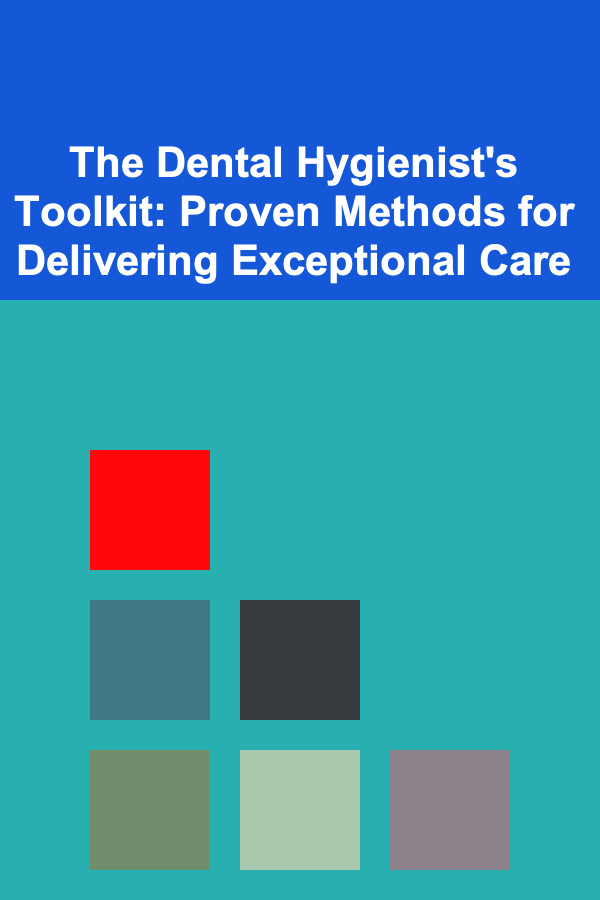
The Dental Hygienist's Toolkit: Proven Methods for Delivering Exceptional Care
ebook include PDF & Audio bundle (Micro Guide)
$12.99$5.99
Limited Time Offer! Order within the next:

Dental hygienists play a pivotal role in patient care, being on the frontlines of preventing and managing oral health issues. To provide the highest quality care, dental hygienists need more than just knowledge of their clinical duties; they require a well-developed set of skills, tools, and methods that allow them to deliver exceptional care to every patient. This guide explores proven strategies and methods that enhance the effectiveness of dental hygienists and ensures the best possible outcomes for patients.
Understanding the Importance of a Structured Toolkit
The work of a dental hygienist is multifaceted, requiring both technical skills and interpersonal abilities. To be truly exceptional in the field, dental hygienists need to equip themselves with the right tools---both literal and figurative. A toolkit is not just about instruments; it also includes techniques, strategies, and mental frameworks that help them excel.
Essential Instruments and Their Proper Use
The dental hygienist's toolkit begins with the instruments that are essential for the execution of daily tasks. Knowing how to properly use these instruments is crucial for delivering exceptional care.
Scaler and Curettes
Scalers and curettes are vital instruments for removing plaque, tartar, and calculus buildup. These tools come in different designs and sizes to address various clinical needs, from the removal of supra-gingival deposits to the treatment of deep periodontal pockets.
- Actionable Tip: Always use the appropriate scaler or curette based on the patient's condition. For deeper pockets, consider using an ultrasonic scaler, which is more efficient in removing larger deposits. However, always combine ultrasonic scaling with hand instruments to ensure precision in areas where the ultrasonic tool may not reach effectively.
Explorer and Probe
The dental explorer and periodontal probe are essential for examining the teeth and gums. They help detect areas of decay, tartar buildup, and potential pockets of infection, giving dental hygienists the necessary information to guide treatment.
- Actionable Tip: Use a periodontal probe to measure pocket depths systematically around each tooth. This data can reveal underlying periodontal disease and help inform decisions about whether scaling and root planing or a referral to a periodontist is necessary.
Polishing and Finishing Instruments
Polishing is a key procedure that not only improves the appearance of teeth but also helps prevent plaque buildup. Tools such as rubber cups and air polishers are commonly used in this process, along with special pastes that smooth the tooth surface.
- Actionable Tip: Always assess the enamel of the teeth before polishing. If the teeth show signs of wear or sensitivity, avoid aggressive polishing. Opt for gentler methods and advise the patient on fluoride treatments to strengthen the enamel.
Mirrors and Lighting
Accurate diagnosis and treatment require a clear view of the oral cavity. A high-quality dental mirror and proper lighting are indispensable for evaluating hard-to-see areas, such as the back of the mouth or deep under the gumline.
- Actionable Tip: Ensure that your light source is positioned at the optimal angle to avoid shadows. A properly angled light will illuminate the target area, enhancing visibility and your ability to perform delicate tasks effectively.
Clinical Skills and Advanced Techniques
Beyond having the right instruments, the dental hygienist must also possess a wide range of clinical skills. These skills not only improve the precision of their work but also help provide a higher standard of care for patients.
Effective Scaling and Root Planing
Scaling and root planing are crucial in the treatment of gum disease. For patients suffering from periodontitis, these techniques help remove bacteria, calculus, and infected tissue from the root surfaces.
- Actionable Tip: Perform scaling in short, overlapping strokes. After scaling, smooth the root surface with a curette to promote gum reattachment. Pay special attention to areas with deep pockets and provide gentle care to minimize discomfort.
Fluoride and Sealants for Prevention
Fluoride treatments and sealants are preventive measures that can reduce the risk of cavities and protect the enamel from decay.
- Actionable Tip: When applying fluoride, choose the appropriate form for the patient's age and needs. For example, fluoride varnish is ideal for children or patients with high caries risk, while fluoride gel may be better suited for adults with dry mouth or weakened enamel.
- Actionable Tip: Sealants should be applied to newly erupted permanent molars in children and teenagers, as they are especially vulnerable to cavities. Assess the occlusal surfaces before applying the sealant to ensure they are free from plaque or debris.
Patient-Centered Periodontal Care
Periodontal care is foundational to maintaining long-term oral health. Regular periodontal maintenance is essential, particularly for patients who have had previous gum disease treatment.
- Actionable Tip: During maintenance visits, closely monitor pocket depths, bleeding, and inflammation. Use a periodontal probe to evaluate changes and adjust treatment protocols accordingly. Patients with chronic periodontitis may benefit from more frequent cleanings to prevent disease recurrence.
Implementing Laser Therapy
Laser therapy is increasingly becoming a vital tool for dental hygienists. Laser treatment can target bacteria and promote tissue regeneration, reducing recovery times and discomfort for patients undergoing periodontal procedures.
- Actionable Tip: Incorporate laser therapy for procedures like soft tissue management and gum contouring. Educate patients about the benefits of laser treatments, such as reduced bleeding and faster healing times.
Effective Patient Communication
The relationship between a dental hygienist and their patients is built on trust and communication. Exceptional care includes not just technical skills but the ability to explain procedures, provide clear instructions, and offer emotional support.
Establishing Trust with Patients
Patients often come to dental appointments with anxiety or fear. By being empathetic, communicative, and patient, dental hygienists can reduce these fears and build trust with patients.
- Actionable Tip: Use a calm, reassuring tone and clearly explain what is happening during the procedure. For example, if performing scaling or deep cleaning, let the patient know when you are about to start and what sensations they might feel.
Patient Education on Oral Hygiene Practices
One of the most important roles of a dental hygienist is educating patients on how to care for their teeth and gums at home. This may include demonstrating proper brushing and flossing techniques or suggesting lifestyle changes, such as dietary modifications.
- Actionable Tip: Use models or visual aids to demonstrate proper brushing and flossing techniques. For patients with specific needs (e.g., those with braces), offer tailored recommendations, such as the use of floss threaders or water flossers.
- Example: For patients who struggle with flossing, suggest alternative cleaning tools like interdental brushes, which may be easier to use and more effective in removing plaque from between teeth.
Addressing Dental Anxiety
Many patients suffer from dental anxiety, which can make regular visits to the dentist difficult. As a dental hygienist, it is important to be proactive in recognizing signs of anxiety and addressing them promptly.
- Actionable Tip: Encourage patients to communicate any fears or anxieties they have about procedures. Offer options for sedation or relaxation techniques, such as deep breathing exercises or the use of headphones with calming music.
Staying Up-to-Date with Advancements in Dental Technology
The field of dentistry is constantly evolving, with new technologies and innovations designed to improve patient care and treatment outcomes. Staying informed about these advancements is key to maintaining an exceptional practice.
Digital Radiography
Digital radiographs provide faster, more accurate imaging than traditional X-rays, and they expose patients to lower levels of radiation.
- Actionable Tip: Familiarize yourself with the latest digital radiography tools, including intraoral cameras. These devices offer clear, high-resolution images that can be used to educate patients about their oral health, making it easier for them to understand the need for treatment.
Teledentistry
Teledentistry allows dental professionals to conduct consultations remotely, which can be particularly useful for patients who cannot visit the office regularly.
- Actionable Tip: Embrace teledentistry as part of your practice to maintain patient engagement and follow-up care, especially for those in rural or underserved areas. Make sure you understand the legalities and best practices for conducting remote consultations.
3D Printing for Dental Applications
3D printing is revolutionizing the field of dental care, allowing dental hygienists and dentists to create custom appliances like crowns, bridges, and even dentures quickly and accurately.
- Actionable Tip: Stay informed about 3D printing capabilities in your office. Familiarize yourself with the process so that you can assist patients in understanding the benefits of these advanced technologies, from faster turnaround times to more personalized treatment plans.
Professional Development and Continuing Education
Being an exceptional dental hygienist means continuously evolving in your field. Participating in professional development opportunities and keeping up with continuing education helps ensure that you are always at the forefront of best practices and innovations in the field.
Attend Workshops and Conferences
Conferences and workshops are excellent opportunities to expand your knowledge base, meet industry leaders, and learn about the latest techniques and technologies.
- Actionable Tip: Make it a priority to attend at least one conference or workshop annually to stay updated on new practices and tools.
Pursue Certifications
Obtaining additional certifications in areas like local anesthesia administration, dental lasers, or advanced periodontal care can enhance your skill set and provide more opportunities for career growth.
- Actionable Tip: Identify areas in your practice where additional training would be beneficial. Whether it's expanding your skillset in treating pediatric or geriatric patients, or learning new technologies, consider pursuing certifications that align with your career goals.
Conclusion
Delivering exceptional care as a dental hygienist requires a combination of technical expertise, communication skills, and a dedication to continuous learning. By assembling a well-rounded toolkit that includes the right instruments, effective techniques, and a commitment to patient education, dental hygienists can provide the highest standard of care. Embracing technological advancements and staying current with industry best practices ensures that your practice remains efficient and patient-focused, creating an environment where both patients and professionals thrive.
Reading More From Our Other Websites
- [Polymer Clay Modeling Tip 101] From Pages to Projects: Turning Polymer Clay Book Tutorials into Real Art
- [Home Maintenance 101] How to Avoid Septic Tank Disasters: A Beginner's Guide to Maintenance
- [Home Cleaning 101] How to Organize and Clean Your Home Office for Productivity
- [Home Maintenance 101] How to Keep Your Home's Septic System in Good Working Order
- [Home Maintenance 101] How to Maintain and Protect Your Home's Landscaping
- [Home Family Activity 101] How to Plan a Family Camping Trip in Your Backyard
- [Home Lighting 101] How to Use Lighting to Make Your Home More Energy-Efficient
- [Home Pet Care 101] How to Create a Pet-Safe Garden and Outdoor Space
- [Mindful Eating Tip 101] Savor the Moment: How Mindful Eating Enhances a Plant-Based Lifestyle
- [Survival Kit 101] Best Tactical Survival Kit for Amateur Preppers Focused on Urban Commutes

Effective Tips for Lowering Student Loan Payments and Reducing Your Debt
Read More
How to Clean Your Home Using Natural Cleaning Products
Read More
How to Make Your Home Feel Brighter with Natural Light
Read More
How to Set Up a Checklist for Managing Your Vacation Photos and Memories
Read More
How To Start Your First Small Business From Scratch
Read More
10 Tips for Stress-Free Holiday Baking: Your Checklist
Read MoreOther Products

Effective Tips for Lowering Student Loan Payments and Reducing Your Debt
Read More
How to Clean Your Home Using Natural Cleaning Products
Read More
How to Make Your Home Feel Brighter with Natural Light
Read More
How to Set Up a Checklist for Managing Your Vacation Photos and Memories
Read More
How To Start Your First Small Business From Scratch
Read More